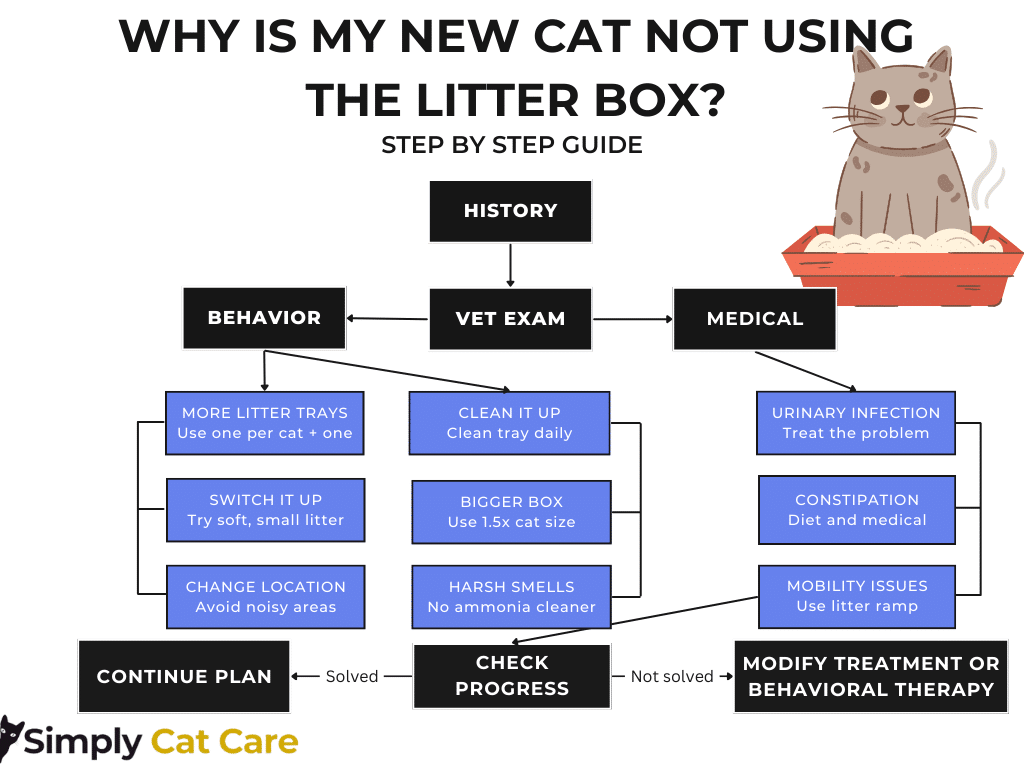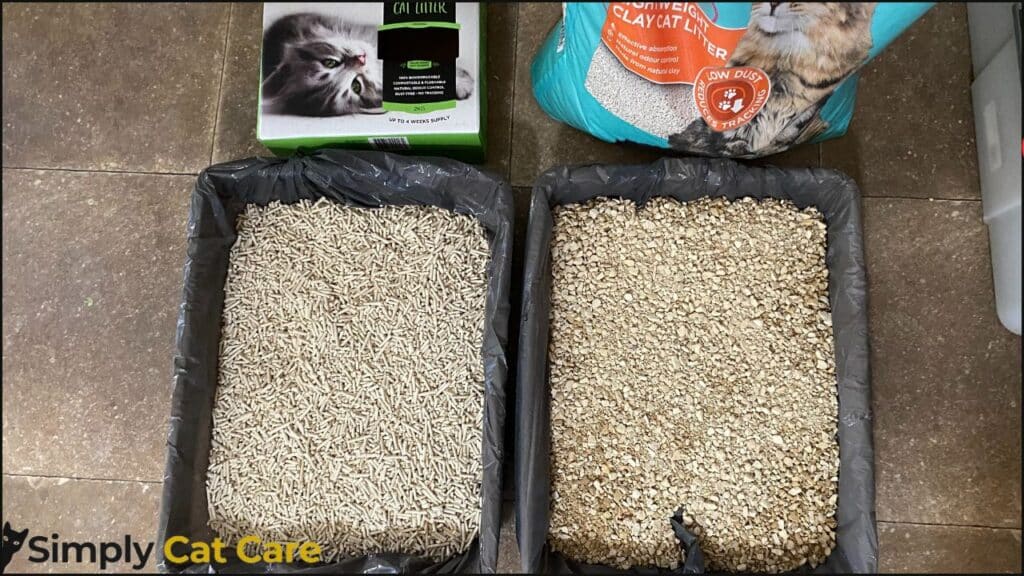Why is my new cat not using the litter box?
Here are the main reasons cats don’t use their litter box:
- Litter box location: Cats prefer a quiet and low-stress location.
- Competition: The new cat may be hesitant to use the other cats litter tray (tip: use one litter box per cat plus one).
- Litter box size: Cats prefer larger size cat litter boxes (tip: aim for 1.5x the size of the cat).
- Cat litter type: Cats prefer small granular litter and may prefer to use unscented litter (tip: compare original litter side-by-side with a different type of litter).
- Cleanliness: A cat doesn’t like to use a soiled tray. Make sure to clean it out daily.
- High sides: Litter boxes with high sides are great to stop tracking, but are problematic for older cats with joint issues.
- Neutering status: Unneutered male cats are more likely to mark outside the litter box.
- Medical issues: Urinary tract infections, bladders and other health issues can cause cats to stop using the litter boxes.
- Bad smells: Ammonia based cleaners smell like urine and can put cats off. Try chlorine based products instead.
Start by observing your cats behavior and preference.
Make small changes. Clean the litter more often, adjust location, and have one cat litter box per cat plus one.
Consult a vet to rule out medical problems, if those strategies don’t help.
Read on for more info about this issue.

Reasons Your Cat Has Litter Box Problems
So your cat is peeing and/or pooing outside the box.
You want take a systematic approach to finding what causes the problem.
Here’s a step-by-step guide on what to do:
Litter Box Preferences
Your cat may not want to use the litter box due to:
- Size: Not being large enough. Aim for 1.5 x the size of the cat as research shows cats prefer larger size litter trays.
- Location: Loud areas aren’t preferable for cats. Competition with an existing cat in the house can also cause issues.
- Number of litter boxes: You need at least one dedicated litter tray per cat, with many experts suggesting to add one extra on top.
- Cleanliness: Research shows cats prefer empty toilets (to be fair, so do I).
Did those strategies help?
If not…
Litter Type Preferences
Some cats prefer smaller size granule litter over long pellets.
I found a moderate correlation between smaller, rounder and lighter litter shape with my kittens wanting to use it.
Experiment with different types. Unscented clumping litter is a good choice for most.
Hot tip:
Compare options side-by-side to find what kittens prefer most.
If that doesn’t help…

Household Stress
New cats take time to adjust to their surroundings.
Being around new pets, people, furniture, smells and sights takes cats out of their comfort zones.
Make sure the litter box is in a place your cat feels safe and can access easily. Consider a safe room for new cats to help get your cat to use their litter tray.
If that doesn’t help…
Behavioral Problems
Take note of when and where your cat is pooping outside the litter box, or peeing.
If their just peeing and spraying on vertical surfaces, it can be a sign of marking behavior.
This is common in unneutered male cats. They do it to advertise themselves to other cats.
Are they meowing whilst going to the toilet?
That’s a sign your cat is trying to tell you something is wrong (either they don’t like the condition of the litter box, or they have a problem like constipation).
Medical Problems and Inappropriate Elimination
If none of those strategies help, see a vet.
They’ll help rule out any medical issues including:
- Urinary tract infections
- Kidney issues
- Constipation
- Arthritis
- Diarrhea
These issues typically make it painful use a litter box.
If that doesn’t help, consider an animal behaviorist.
Negative association with the box are potentially difficult problems to solve by yourself.
Declawing and litter box issues
Removing a cats claws can lead to pain and they can stop using their litter.
A 2018 study found a 4 times higher risk of declawed cats toileting outside their litter box.
The procedure can cause fragments in the phalanges of the paw which increase pain. Harder litter can simply be too painful to step on and lead to avoidance.
Old age
Up to 60% of cats have osteoarthritis in at least one limb.
As cats age, the risk of problems affecting mobility. Not using the litter box is one of the first signs that your cat is having trouble.
Ramps are helpful solutions for older cats to get near their litter box with less struggle.
What if My Cat hasn’t used the litter box in 24 hours?
If your cat isn’t using the litter box or toileting at all, it’s a sign of a medical problem.
Look for other signs of illness including:
- Vomiting
- Lethargy
- Loss of appetite
Search for hidden places a cat may have gone. If your cat continues to stop using their litter boxes, see a vet.
Final Thoughts
Some reasons why your cat is going outside of the box include:
- Competition with existing house cat
- Certain litter types (e.g. hard long pellets)
- Age related changes (e.g. arthritis)
- Household stress (e.g. young children)
- No dedicated box for each cat
- Not scooping the litter box daily
- Using too small a litter tray
- Medical issues (e.g. constipation)
- Marking behavior (common in unneutered cats)
- Pain (declawing can increase pain)
Try a different litter, new box and new location. If simple fixes don’t work, or your cat shows symptoms of illness, see a vet.
Related:
